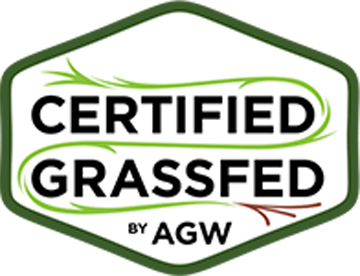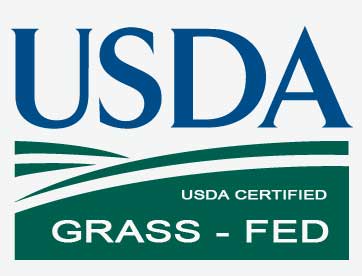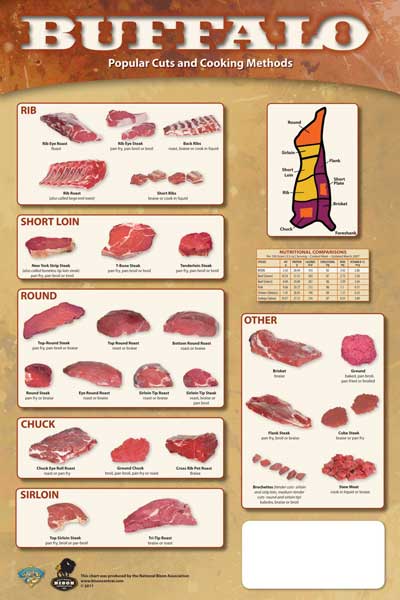What, When, and Where
We process animals once a year, at 24-30 months of age, during the month of September after the animals have been feeding on fresh green grass the entire summer. We believe that this age and time produces the best quality meat. All of our animals will be processed thsi year at the USDA inspection plant in Mount Vernon, AR (5R Custom Mests).
Our bison are USDA & AGW certified grass-fed and processed at 2-years of age. They do not weigh in the 1000-1200# range of grain fed animals or 3 yrs or older so-called "grass-fed animals". As such, our animals are generally in the 750-850 pound range live weight with a hanging hot weight (HHW) of 400-450#. Quantity is replaced with Quality.
We decide on how many animals will be offered for sale each year during the month of July and post notices on Facebook as well as send notices through our newsletter. To sign up for notices, subscribe to our Newsletter, email us at , and/or follow us on Facebook
Of course you can purchase an animal at anytime and have it processed at any location you choose, there are several options. Feel free to Contact Us for additional information
Our Bison Meat is a Healthy Choice
All of our animals are pasture-raised, certified animal welfare approved, Certified grass-fed, and grass finished without any antibiotics or hormones, ever. Our animals have never seen a spec of grain or any grain by-product in their entire life.
We were the first and currently the only USDA Certified Grass-Fed herd in North America (certificate # GF2014JBA). Combined with our Grass-Fed and Animal Welfare Certifications by A Greener World, we are really grass-fed and only grass-fed with defined standards. Read what Certified Grass-Fed really means.
Why buy in bulk?
Bulk bison meat is available in the form of a whole bison by advanced special order. By arrangements, special bulk packages may also be arranged. The benefits to buying in bulk include:
- Access: Having a full portion of bison in your freezer makes it easy to decide what's for dinner. You have a huge choice of healthy meat options just a few feet away from your kitchen.
- Variety: You have a choice in how your meat is cut and processed. You can decide on the thickness of your steaks and whether you want your roasts to be small, medium or large in size. Additionally, soup bones, tongue and organ meats (heart, liver, etc.) are part of the bison carcass and are included in a bulk purchase. Buying the live animal rather than the meat, you also get the hide and the skull if you want them.
- Lower Cost: If you are interested in a variety of cuts, buying in bulk is the most economical option.
Some people hesitate to buy bulk bison because they think it will be too much meat. If a full bison seems like too much, consider splitting it with family or friends.
We offer several approaches and opportunities to purchase bulk bison including:
- Purchase a Market-Ready Live Animal
This is the easiest, most cost efficient, and convenient method of buying bulk bison meat. You come to the farm, purchase a 24-30 month old market ready animal, and we transport it to the processing plant in Miami Oklahoma (Quapaw Meat Authority) at no cost. All you need to do is pick up the meat from the processor or from the farm. Alternately we will transport your bison to the processing plant of your choosing for a fee.
Being 100% certified grass-fed, we generally process our animals once a year, in September, after they have been feeding on fresh green grass all summer. Although you can have your animal processed any time, September is our recommendation. Our market ready animals (24-30 month old bulls) currently sell for $3,650, which does not include processing.
Since this is your animal, you can have anything you want including organs, hides, skulls, hoofs, etc. Reservations and deposits are generally accepted in July of each year. We require a 50% deposit on all whole animal purchases. Because we generally have more demand than animals available, it is best to purchase your animal early. - Purchase a young animal
For those unable or unwilling to purchase a market ready animal or full carcass, we offer the ability to purchase a young calf or yearling and have us raise it for you. Many of our animals are sold this way. It gives the buyer (owner) complete control over their animal - it is a simple absentee-owner arrangement. This arrangement works as follows:
- Purchase a young bison at calf or yearling)
- Pay a monthly maintenance fee of $75.00 per month for its care (It costs between $2.75-$3.00 per day to raise bison and this was before the current inflation rate)
- We will provide complete care of your animal, including but not limited to feed and veterinary services
- When the animal is at market weight, or any time designated by you, we will transport the animal to the processing plant for you.
- You instruct the processing plant how you want your animal processed and you pick up the meat when ready
- Purchase a young bison at calf or yearling)
- Buying a quarter or half
We no longer sell quarters or halves. However, if you are interested in purchasing the equivalent of a quarter bison (100 or more pounds of meat) or a half (200 or more pounds of meat, special pricing can be negotiated and arranged.
Frequently Asked Questions
When should I order?
We recommend that you reserve your animal early in the season or we may be out of stock for the year. Our regular customers, restaurants and groceries, take precedence. Whole animals are sold on a first-come basis. Remember that this takes time and we can't just whip another one up for you on the spot. Make your arrangements as early as possible.
How should I order?
You first need to contact us. We recommend that you visit our farm in person to make your arrangements to avoid any confusion or misunderstanding.
When can I get my meat?
We generally only harvest animals during the months of September, thus it is important to reserve your bison early to insure we have sufficient meat and/or animals to accommodate you. Although we will slaughter animals at other times of the year by special order, we find September to be the best time to harvest grass-fed and finished animals after they have been feeding on nutritious lush green pasture for several months.
Where and when can I get my animal slaughtered?
Bison are large wild animals and not all processing plants can or will handle these animals. Because of the difficulties in dealing with these animals, you cannot usually just take them to a processing plant as you would a domestic steer; you generally need to make special arrangements in advance. Again, plan early. Make sure the plant has the facilities to handle bison. We process all bison at the USDA inspected plant at the Quapaw Meat Authority in Miami, OK
How much meat can I expect from a whole bison?
The hanging hot weight is what is left after you remove the parts that are inedible like the hide, feet, head, some of the bones and most of the innards. The dressing percentage for most bison is about 56%, lower than beef because of their heavy hide and head. Most grass-fed bison will weigh between 750 and 850 pounds at 25-30 months of age (grain fed animals will weight more).
As an example, a 25-30 month bison weighing 800 lbs. would "dress out" or have a hanging hot weight of about 448 lbs (800 x 0.56). Of that hanging hot weight, you take home the finished cuts or "yield" which is generally 65% to 75% of the hanging hot weight (because of the lean meat, bison have a higher yield than beef). Thus, from that 800 lb animal you should get about 250-300 lbs cut and packaged for your freezer. This will vary depending on how you want your meat processed; for example, boneless would have a lower yield than bone-in cuts. All meat is cryovac sealed for safe and extended freezer time to protect meat from freezer burn.
Bison are processed and cut a little different than beef for a variety of reasons. Bison have an extra rib and you cannot get a hump roast off a beef cow. From the processed meat, about 17% will be steaks, 55% will be ground bison, 25% will be roasts (which can also be ground or stew meat if roasts are not desired), and 3% will be other (short ribs, shanks, soup bones, etc). See Bison Cuts Chart
If you choose standard processing and cuts, you could expect to get approximately the following cuts and quantities:
- Tenderloin filets – approx. 4-6 lbs.
- Strip loin steaks – approx. 8-10 lbs.
- Ribeye steaks – approx. 9-12 lbs.
- Sirloin Steaks – approx. 12-16 lbs.
- Flank/Skirt Steaks - approx. 1-2 lbs
- Chuck Roast – approx. 10-16 lbs.
- Round Roast - approx. 7-10 lbs.
- Hump Roast - approx. 12-15 lbs.
- Brisket – approx. 8-10 lbs.
- Back and Short Ribs – approx. 6-8 lbs.
- Stew Meat – approx. 12-16 lbs.
- Oxtail - approx. <1 lb.
- Marrow/Soup bones - approx, 20-22 lbs.
- Buffalo Fries (oysters) - approx. 1-2 lbs.
- Ground – approx. 140-160 lbs.
This will require approximately 8-10 cu. ft. of freezer space


Whole Bison: $3,650 *
price does not include processing
* Price is based on a 400-450 pound hanging hot weight (HHW) on a bull and 350-400 pounds HHW on a heifer. Cost will be proportionately discounted if the HHW falls below 400# for a bull and 350# for a heifer.

